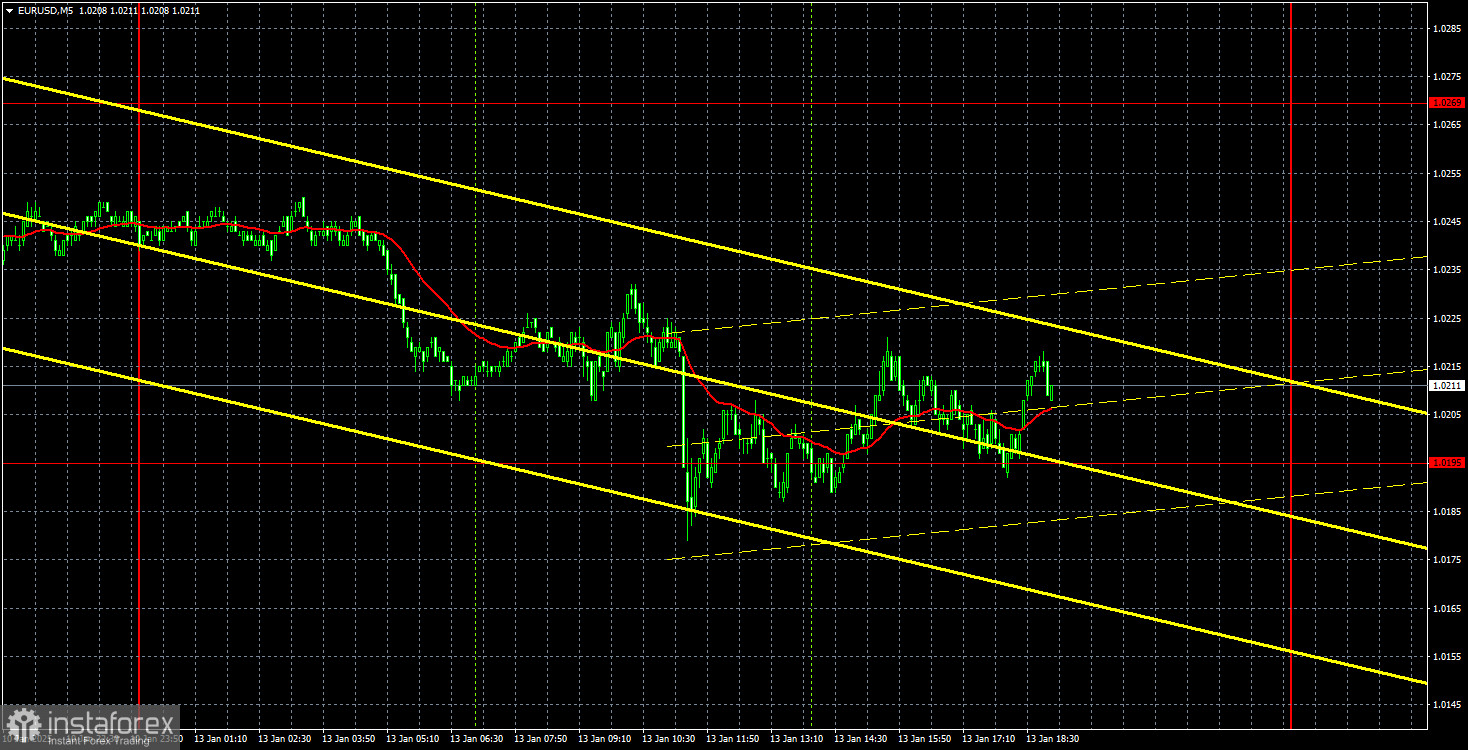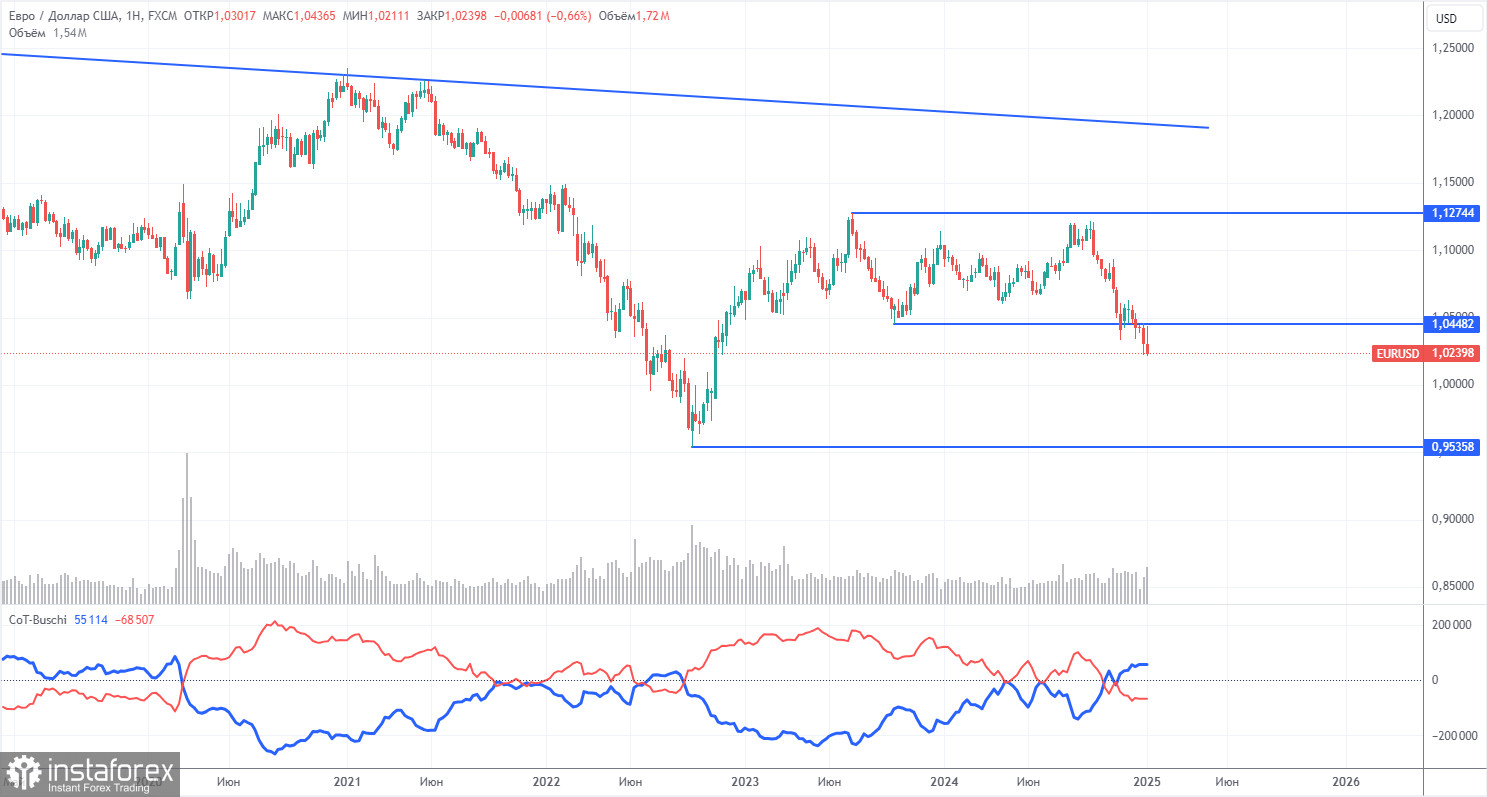EUR/USD 5-Minute Analysis

The EUR/USD currency pair continued to decline on Monday, and it has become somewhat repetitive to mention this, as the euro has been falling consistently. This time, the pair reached the 1.0195 level, achieving our target range of $1.00–$1.02, as we had previously anticipated. However, we believe this does not mark the end of the euro's decline, as higher timeframes continue to indicate a long-term downtrend. While such trends eventually come to an end, there are currently no signs of a reversal.
On Monday, there were no significant economic releases or events in either the Eurozone or the U.S. Nevertheless, this did not stop the market from continuing to sell the euro. This reinforces the idea that global factors, rather than local ones, are driving the pair's movement. The global factors contributing to the euro's decline have been discussed extensively since last year, and no substantial changes have occurred. While the euro may experience temporary corrections, one might question the value of buying it when these movements appear to be purely corrective, especially given that previous corrections have been so weak.
On the 5-minute chart, several buy signals appeared around the 1.0195 level on Monday. Although buy signals can be significant, taking long positions during a strong downtrend is generally unwise. Additionally, these signals were notably imprecise, leading us to disregard them. Nevertheless, the second level did temporarily stop the euro's decline—for the time being.
COT Report

The latest Commitment of Traders (COT) report, dated December 31, indicates that non-commercial traders maintain a bullish net position. However, bears have recently gained the upper hand. Two months ago, the number of short positions among professional traders surged, resulting in a negative net position for the first time in a long while. This change suggests that the euro is being sold more frequently than it is being bought.
We have yet to identify any fundamental drivers for euro strength. From a technical perspective, the EUR/USD pair has been consolidating for quite some time. On the weekly timeframe, it has traded between 1.0448 and 1.1274 since December 2022. The breach of the 1.0448 level has opened the door for further declines.
Additionally, the COT data shows that the red and blue lines have crossed, signaling a bearish market sentiment. In the last reporting week, long positions among non-commercial traders increased by 9,300, while short positions rose by 10,400, resulting in a reduction of the net position by 1,100.
EUR/USD 1-Hour Analysis

On the hourly timeframe, the currency pair has resumed its downtrend, which has been ongoing for over three months. We expect this decline to continue in the medium term. The Federal Reserve may cut interest rates only 1 to 2 times in 2025, which indicates a more hawkish stance than the market had anticipated. Therefore, we see no justification for significant growth of the euro. The pair remains bearish, even in the short term, as it trades below the Ichimoku indicator lines.
For January 14, we highlight the following trading levels: 1.0195, 1.0269, 1.0340–1.0366, 1.0461, 1.0524, 1.0585, 1.0658–1.0669, 1.0757, 1.0797, 1.0843, and 1.0889. Additionally, pay attention to the Senkou Span B at 1.0342 and the Kijun-sen at 1.0307. The Ichimoku lines may shift throughout the day, so traders should adjust accordingly when determining signals. Remember to set a stop loss at breakeven if the price moves 15 pips in your favor to mitigate potential losses from false signals.
The only noteworthy event on Tuesday is the release of the Producer Price Index (PPI) in the U.S.; however, we consider this report relatively minor. Later in the week, U.S. inflation data will be published, which deserves special attention. This report could potentially shift market expectations towards a more dovish outlook for Fed rate cuts in 2025, which might halt the dollar's rally.
Illustration Explanations:
- Support and Resistance Levels (thick red lines): Thick red lines indicate where movement may come to an end. Please note that these lines are not sources of trading signals.
- Kijun-sen and Senkou Span B Lines: Ichimoku indicator lines transferred from the 4-hour timeframe to the hourly timeframe. These are strong lines.
- Extreme Levels (thin red lines): Thin red lines where the price has previously bounced. These serve as sources of trading signals.
- Yellow Lines: Trendlines, trend channels, or any other technical patterns.
- Indicator 1 on COT Charts: Represents the net position size for each category of traders.





















